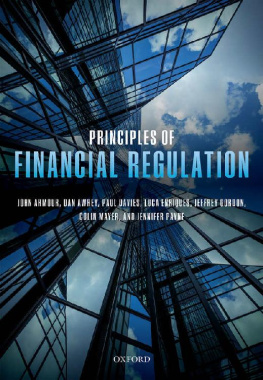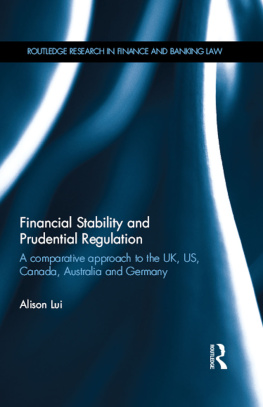Principles of Financial Regulation
John Armour , Dan Awrey , Paul Davies , Luca Enriques , Jeffrey N. Gordon , Colin Mayer , and Jennifer Payne


Great Clarendon Street, Oxford OX2 6DP, United Kingdom
Oxford University Press is a department of the University of Oxford. It furthers the Universitys objective of excellence in research, scholarship, and education by publishing worldwide. Oxford is a registered trade mark of Oxford University Press in the UK and in certain other countries
J. Armour, D. Awrey, P. Davies, L. Enriques, J. Gordon, C. Mayer, and J. Payne 2016
The moral rights of the authors have been asserted
First Edition published in 2016
Impression: 1
All rights reserved. No part of this publication may be reproduced, stored in a retrieval system, or transmitted, in any form or by any means, without the prior permission in writing of Oxford University Press, or as expressly permitted by law, by licence or under terms agreed with the appropriate reprographics rights organization. Enquiries concerning reproduction outside the scope of the above should be sent to the Rights Department, Oxford University Press, at the address above
You must not circulate this work in any other form and you must impose this same condition on any acquirer
Crown copyright material is reproduced under Class Licence Number C01P0000148 with the permission of OPSI and the Queens Printer for Scotland
Published in the United States of America by Oxford University Press 198 Madison Avenue, New York, NY 10016, United States of America
British Library Cataloguing in Publication Data
Data available
Library of Congress Control Number Data available
ISBN 9780198786474 (hbk.)
ISBN 9780198786481 (pbk.)
ebook ISBN 9780191090059
Printed and bound by CPI Group (UK) Ltd, Croydon, CR0 4YY
Links to third party websites are provided by Oxford in good faith and for information only. Oxford disclaims any responsibility for the materials contained in any third party website referenced in this work.
How We Came to Write This Book
On Monday, 15 September 2008, Lehman Bros entered bankruptcy proceedings. That afternoon, two of us were running a class on comparative corporate law in New York. As we arrived in class, one of us passed a note to the other: I withdrew $500 before class. Dont know if ATMs will still be working after.
The class, ironically, was about bubbles. But when a student asked us how we could explain what was happening downtown, we realized we had no convincing answers.
We began reading about banks and banking regulation; the more we read, the more unhappy we became. In a paper written a number of years earlier, Charles Goodhart and colleagues had forcefully criticized the then new Basel II accordwhich by 2008 was the centrepiece of banking regulation around the worldon the basis that it would make the financial system more procyclicalthat is, more prone to boom and bust. They observed prophetically:
[The Basel II] proposals, taken together, will enhance both the procyclicality of regulation and the susceptibility of the financial system to systemic crises, thus negating the central purpose of the whole exercise. Reconsider before it is too late.
Why had no one listened? We turned next to literature on banking regulators. In the US, we found that oversight of investment bankslike Lehmanunder the Basel II framework was being undertaken by the Securities and Exchange Commission (SEC). The SEC was a market regulator, and had no mandate to care about financial stability. But why should market regulators not care about financial stability? And if they did not, why should investment banks be allocated to a market regulator?
In the UK, the Financial Services and Markets Act 2000 had, to great fanfare, recently merged the oversight of all aspects of financial regulation in the UK, including banking. The legislation did not include financial stability amongst the goals the new Financial Services Authority was required to pursue. Why was this not thought relevant?
The more we thought about it, the more we felt convinced that the breadth and depth of the currents in the financial system had simply flowed past and around regulators tied to particular islands of jurisdiction and expertise. The lack of appreciation of the wider picture was startling. The starkness of the errors, and the gravity of the consequences, meant that financial regulation became a major research interest for us, in a way that it had not previously been.
Financial regulation soon became a huge growth industry. Others had had the same reaction as us. Everyone had an opinion, it seemed, and everything was being changed, all at once. But if there were problems with the coordination of ideas before, how could these possibly be solved by proceeding in this way?
The following year, a group of us in Oxford decided to launch a new course, Principles of Financial Regulation, for our graduate studentsincluding those taking our new MSc in Law and Finance. We felt that people entering the professional world who might work in, or with, the financial sector would value the chance to engage critically with what was going on. It would also give us a chance to try to organize our thinking in a systematic way.
There were two central challenges to this undertaking, however. The first was the breadth of potentially relevant material and the range of interconnection. The second was the pace of change. The breadth of material meant that it would be very difficult to offer a course that would provide detailed engagement with regulatory measures to the level needed to advise about compliance. The pace of change meant that, even if it had been possible to offer such detail, it would have been futile, because the content stood a high chance of being outdated before students actually got to put it into practice. Besides, large law firms have tremendously sophisticated in-house teams who aggregate and analyse the latest information at a highly detailed level. There would be little comparative advantage to us trying to replicate this in a university.
So we decided instead to develop what we think of as a macro approach. Just as we think of the discipline of economics as split into macro and micro branches, so too might we approach legal scholarship. A macro project is one that looks at the level of the system as a whole, and understands the interrelation of the various components at the aggregate level. In particular, we thought it was important to offer a treatment that could comprehend the regulation of both securities markets and banks, which had traditionally been treated as entirely different, despite the increasing functional overlaps. Of course, a macro system must be built on sound micro foundations. But in order to give an understanding of how things work at the macro level, it is not necessary to convey all the detail of the micro foundations. What we wanted to do was to give a roadmap to the regulation of the financial system, which students could use to situate their understanding of the rules.
In particular, we thought it would be helpful to present substantive rules from the major jurisdictions involved in the financial crisisthe US and the EU (and especially, within the latter, the UK, given our base)as exemplifying policy choices. This allows for a treatment that presents large-scale principles, upon which examples of particular policy choices are hung. The approach emphasizes the interaction of policy choices and the consequences one piece of the jigsaw has for the others. But it is of course not comprehensive.










